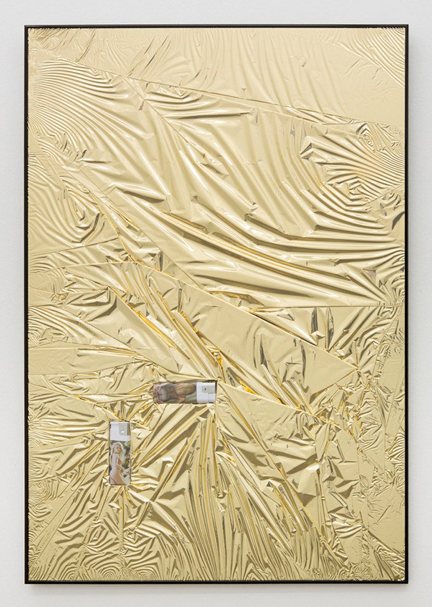Samuel Francois, The Joy of Man, Courtesy of Rod Barton Gallery.
By Vanessa Saraceno
Aiming to explain a “certain idea of eroticism”, French artist Samuel Francois presents a new series of works, collectively titled The Joy of Man, as the exhibition at Rod Barton Gallery, London. It is his first solo show in the UK. Inspired by childhood memories of images and sensations, the project manipulates the artist’s own memories of his father’s garage with the stereotypical imageries of a car repair shop.
Personal histories have been embedded in these works, such as the oversized lighters and the crumpled foils surrounding them. These lighters are printed with images of porn models striking various sensual poses. Images of desire and seduction accompany the melancholy in this walk through the grotesque images of bygone imageries. A closer reading of the works suggests that maybe even his own memories have been turned into popular or stereotypical representations.
Accidental outcomes are employed by the artist to manipulate the way people typically see things and to stimulate multiple readings at once. Mixing different and unusual objects, Samuel Francois examines the purposeful nature of what remains – loose ends that persist, although the subject is gone. A glossy gold is employed here to query any decorative attempt to create images of seduction, like the survival blankets that are usually used by runners after a marathon to regulate the body’s heat.
Samuel Francois answered a few questions I had about his project at Rod Barton Gallery in London. He shared how it started and developed, and to what extent his activity as a publisher influenced his artistic projects.
Vanessa Saraceno: How did you start this project and why?
Samuel Francois: I think the day I found the lighters. The size of the lighters is really big and it was impossible not see to them in the shop. I bought them, and I tidied them up in a box at the studio. One day Justin Morin invited me to participate to an exhibition for which we had to propose a work in connection with Bobbi Woods’ piece which appropriated a poster of Emanuelle, a French erotic movie. The subtitle of this movie is The Joy of Woman. On that occasion, I created the first piece of this project.
VS: In The Joy of Man you examine the possibilities to provoke multiple readings by connecting objects and connected imageries in spontaneous and unexpected ways. Can you tell me more about the stereotypical representation you use in your work?
SF: I always proceeded in a spontaneous way, confronting objects of diverse universes. Mostly, I buy things and then find their peer/complement in the studio. The works change when I install them. Also, the images I use don’t tell the same thing to every person. What seems to be a joke to me, maybe it’s perceived by other people like a misogynous work, and I’m not yet aware of that. For me, The Joy of Man tells more about the discovery of eroticism for a child rather than sex. Posters and calendars seen in my father’s garage were the first pictures of a naked woman I saw in my life. They were not vulgar. These are the kind of images that make both men and women smile as they see them. I make things and then everyone is free to make his own interpretation.
VS: In your work you use a variety of media, mixing discarded materials with post-industrial elements and memories from your childhood. It seems you want to draw attention to the way society values objects and provoke awareness about this process. What is your view of the relationship we have with our environment today?
SF: I have the romantic vision of a painter. I dreamed to be a painter and did a lot of paintings in my studio. I never limited myself to a medium, always using the one that seemed the best for my comment/work/idea. During a residency at Cripta 747 in Torino, Italy, I produced a white neon with the text “No Image Yet” because I didn’t manage to decide from what to begin, and why to choose one voice/way more than another. For La Nuit Blanche in Paris, I showed this piece for the second time, but bigger, around 8m in length. The public was lost because they waited for something but there was nothing, just the text. There was a feeling of frustration, but at the same time the public had taken its time to settle in one moment. People remained there to have a drink of wine, to speak, to criticize…it was a break in the nightly race of contemporary art. I tell you this because sometimes I wonder why I do art, and what is useful in order to produce a new piece. Maybe this is one of the reasons why I use the objects of my environment.
VS: You work as artist, curator and publisher at Blank Edition. To what extent these varied experiences influence your artistic production?
SF: I need to make these things incorporated to my practice. I buy many books, catalogs, and old books. I also collect artists’ books and three years ago I thought that I could accompany artists and help them by making a publication. Most of them are friends or people whose work I like. When I organize an exhibition it’s the same. I make an exhibition with pieces that I would have liked to make. I choose pieces that have a link with my working themes and use them to serve my comment. I dreamed to paint like Jean-Baptiste Bernadet or to have a simple relationship with the city like Olivier Kosta-Théfaine, so using their work is a certain way of making an exhibition that I would have liked to make alone.
























